Shoulder Prehab
Rest between sets: As Needed
Intensity: Light
workout_number sort_number Demo Exercise Reps/Sets How to/Cues
adg 1 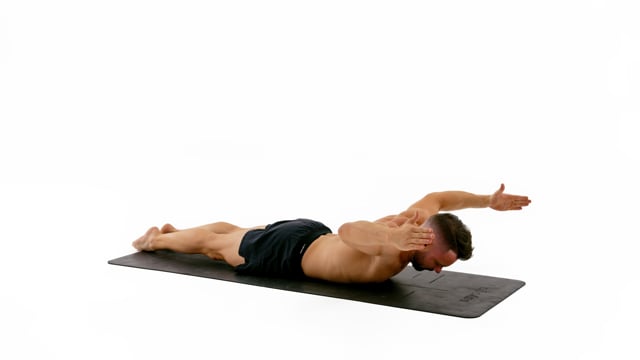
Rotate your hands for the thumbs to point towards the ceiling as your bring your arms to the W. Make sure you have a 90 degrees angle in your shoulders and that your elbows are in line with the shoulders. Pull your hands and elbows up towards the ceiling and not back.Keep your chest on the floor the entire time and rotate your hands for the thumbs to point towards the ceiling.Keep your legs engaged but on the floor. Point your feet and make your ankles touch.
adg 2 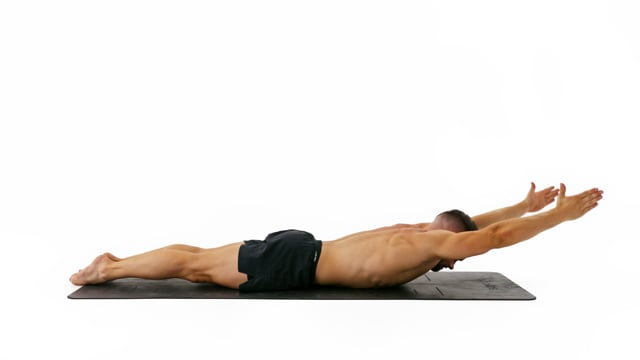
On the way back stop with your elbows in line with your shoulders and a 90 degree angle in your elbows. Lift your forearms towards the ceiling and squeeze on top for a moment.Keep your chest on the floor the entire time and rotate your hands for the thumbs to point towards the ceiling.Keep your legs engaged but on the floor. Point your feet and make your ankles touch.
adg 3 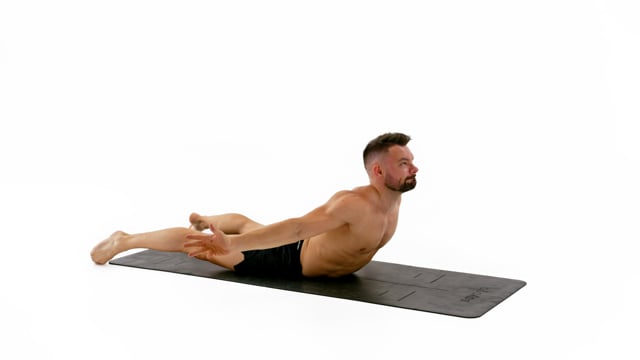
Then externally rotate your arms, squeeze your shoulder blades together in the back, look up towards the ceiling and engage the whole back lifting the upper body of the floor.Keep your feet about shoulder width apart on the floor the entire time.Move slowly! The longer this takes the more control and strength you will develop!
adg 4 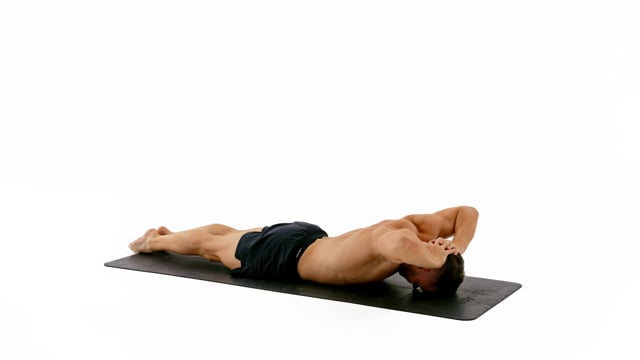
Lift your elbows up as you were trying to make them touch behind your head. Bring them back down slowly. Do not slam them into the floor.Keep your legs engaged but on the floor. Point your feet and make your ankles touch.Move slowly! The longer this takes the more control and strength you will develop!
adg 5 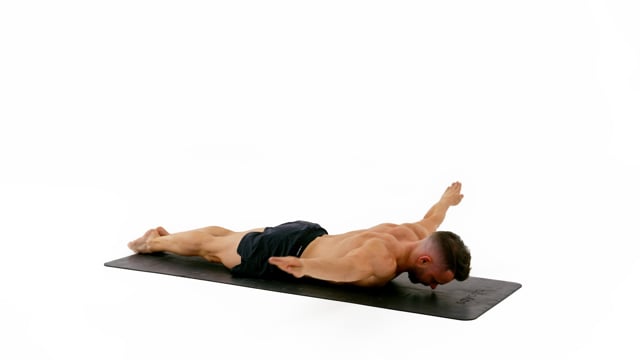
Keep your chest on the floor and lift your head sligthly.Keep your legs engaged but on the floor. Point your feet and make your ankles touch.
6
beh 7 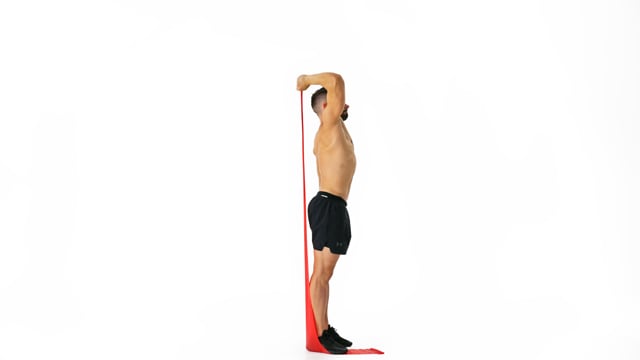
Allow your shoulder to move and elbow to flare naturally as your bend your arm.Engage your core to stabilize your position.Exhale as you extend the arm. Inhale on the way back.
beh 8 
Engage your core to stabilize your position. Minimize arching of the lower back.Lock your elbow and look at your hand.This is a core activation drill and not a back stretch. Do not bend too far towards the back!
beh 9 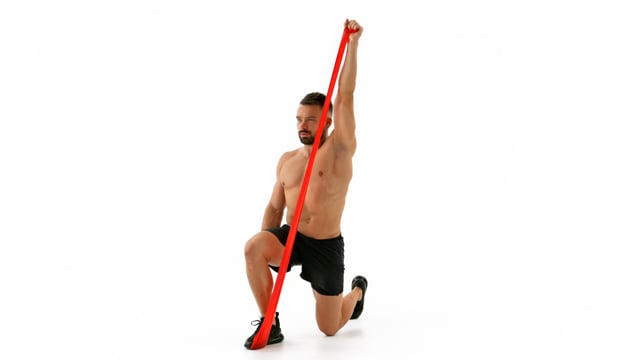
Stop lowering the arm with your elbow next to your shoulder and 90 degrees bent.Engage your core to stabilize your position.Exhale as you extend the arm. Inhale on the way back.
beh 10 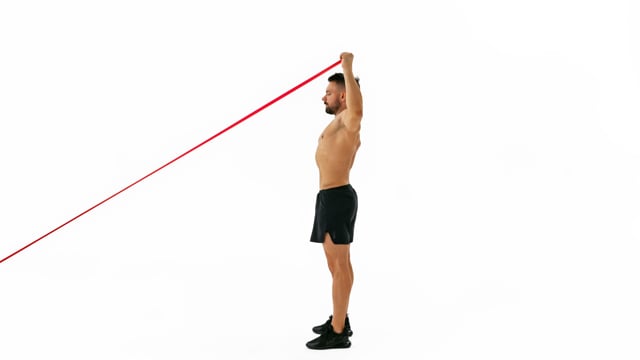
Separate your movements. First pull your hand back and up aligning your elbow with the shoulders, then rotate the arm and finally press the hand overhead. Follow this same path on the way back down.Imagine you had a solid stick going through your shoulders and the working arm all the way to your elbow. Rotate the arm on this axis.Stand far enough from your attachment point so you can apply constant backwards pressure on the elastic as you extend your arm overhead.
beh 11 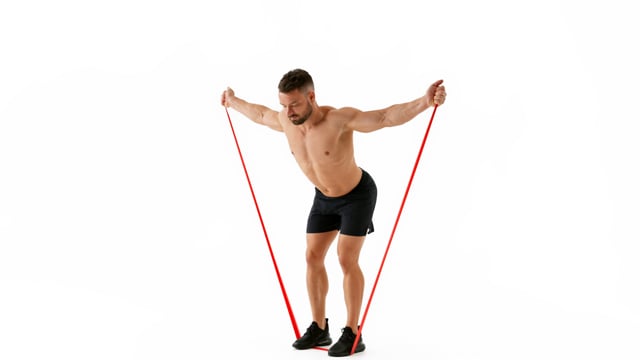
Keep your shoulders low and pull your arms back as if you were trying to touch your elbows behind your back.Rotate your hands so the thumbs are guiding the movement and the elastic is leaving your firsts on the pinky side.Exhale as you pull your arms back.
12
cfi 13 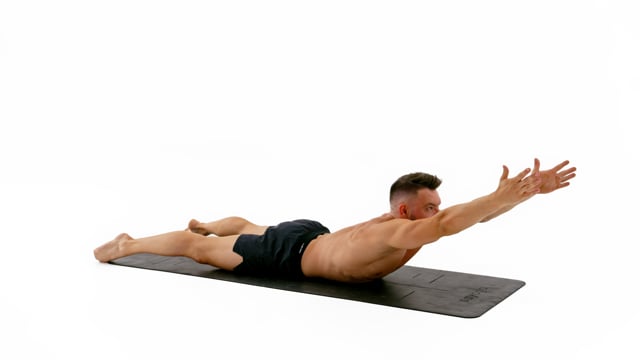
Externally rotate your hands as you move your arms towards the front. As your hands reach the front the thumbs point towards the ceiling. Reverse this as you bring the hands back down.Keep your feet about shoulder width apart on the floor the entire time.Move slowly! The longer this takes the more control and strength you will develop!
cfi 14 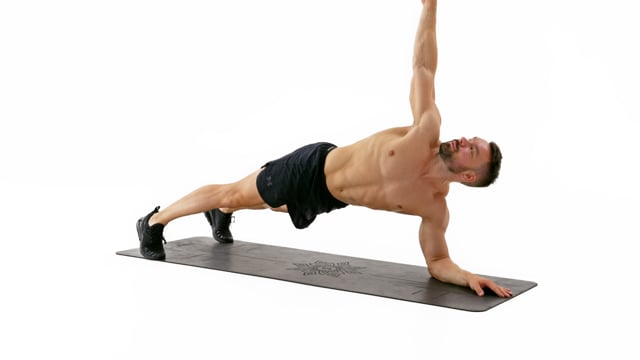
Engage your core and create 1 straight line from your feet all the way through your neck.Look up as you reach towards the ceiling. Both of your arms should end up in 1 straight line.Move slow and stay in control at all times!
cfi 15 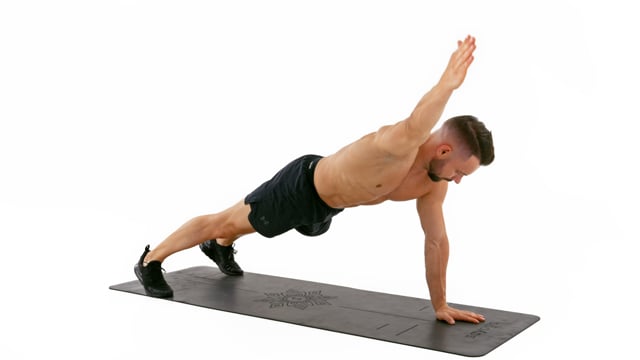
Engage your core and create 1 straight line from your feet all the way through your neck.Lift one arm at the time out diagonally in a 45 degree angle. Your thumb needs to point towards the ceiling.Keep your shoulders and hips immobile.
cfi 16 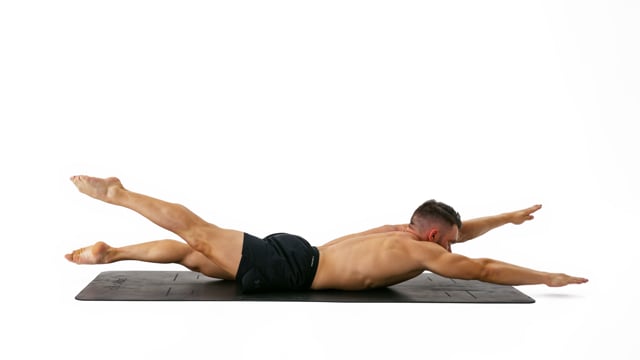
Pull your hands and feet far away from your center to get as long as possible.Keep your core engaged to stabilize your position and isolate the movement into your arms and legs only.Go as fast as possible.
cfi 17 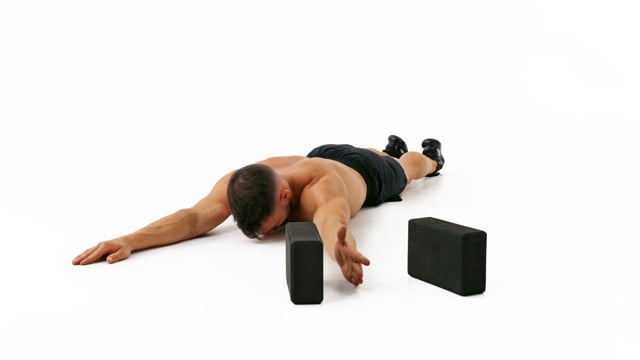
Relax your hands back on the floor between each rep.Keep your chest on the floor the entire time and rotate your hands for the thumbs to point towards the ceiling.Keep your legs engaged but on the floor. Point your feet and make your ankles touch.
Rest between sets: As Needed
Intensity: Light
workout_number sort_number Demo Exercise Reps/Sets How to/Cues
a d g j 1 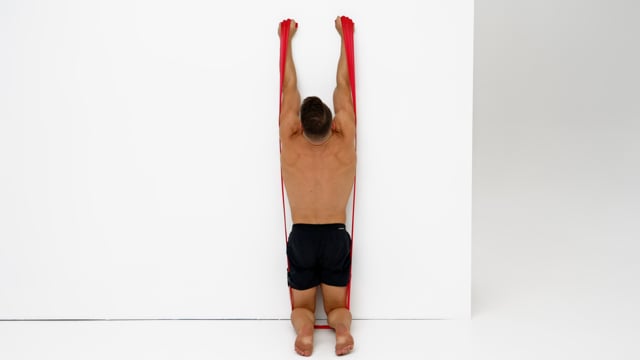
Lock your elbows and look at your hands.Reach towards the ceiling pushing as tall as you can and cover your ears with your shoulders. Make sure the elastic comes out of the back of your hands like an extension of your fingers and not from the thumb or pinky side.Go slow on the way down and keep your elbows locked. Both directions matter!
a d g j 2 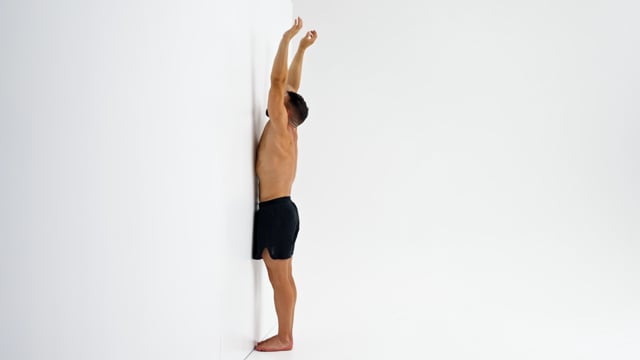
Keep your quads, hips and chest connected with the wall at all times.Lock your elbows and look at your hands.
a d g j 3 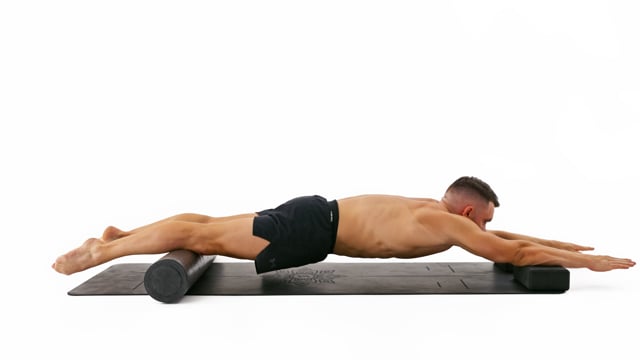
On the bottom end of the body the elevation should be on the quads just before the knees.Look at your hands and keep them around shoulder width apart.Push your lower back up and engage your core to create an even and slightly rounded line.
a d g j 4 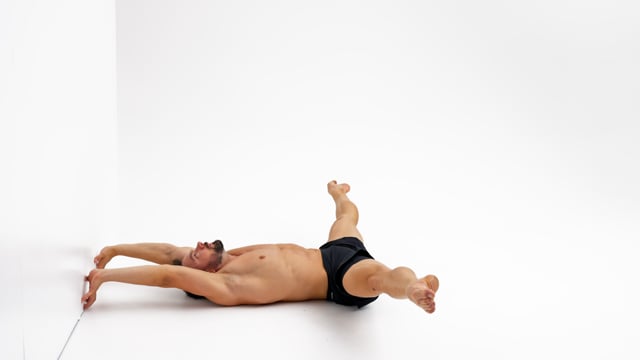
Squeeze your knees together in the tuck position. Bring them as far as possible towards your chest without allowing your lower back to round. Keep your coccyx on the floor.Lift your hands off the floor and push them into the wall hard by elevating your scapula. Try to cover your ears with your shoulders!Tilt your head back slightly and try to look at your hands to mimic the position you would be in when performing a handstand.
5
b e h k 6 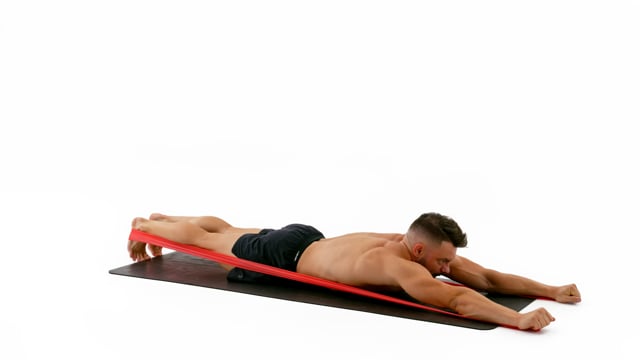
Reach as tall as you can and cover your ears with your shoulders.Lock your elbows and look at your hands.Do not lift your chest off the floor. Isolate the movement into your shoulders.
b e h k 7 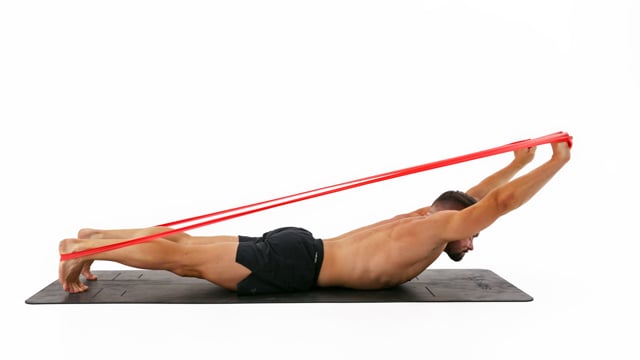
Hover your chin close to the floor.Lock your elbows and look at your hands.Do not lift your chest off the floor. Isolate the movement into your shoulders.
b e h k 8 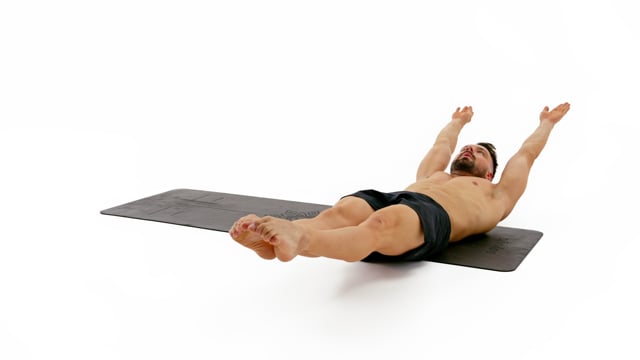
Lock your knees, point your feet and squeeze them together.Keep your head in a neutral position but pull it back slightly as you roll onto your stomach.Engage your entire body from hands to toes.
b e h k 9 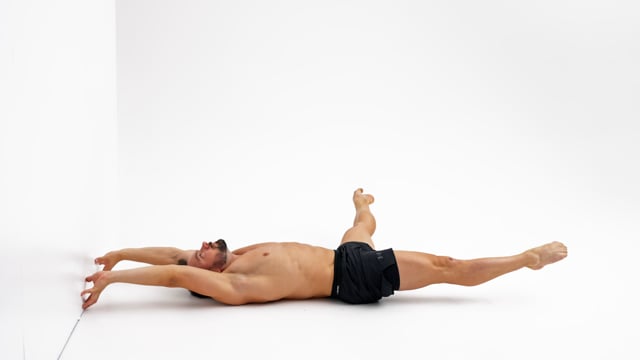
Keep your immobile leg engaged and hover the foot off the floor. Do not allow your hips to move at all during this drill.Lift your hands off the floor and push them into the wall hard by elevating your scapula. Try to cover your ears with your shoulders!Tilt your head back slightly and try to look at your hands to mimic the position you would be in when performing a handstand.
10
c f i l 11 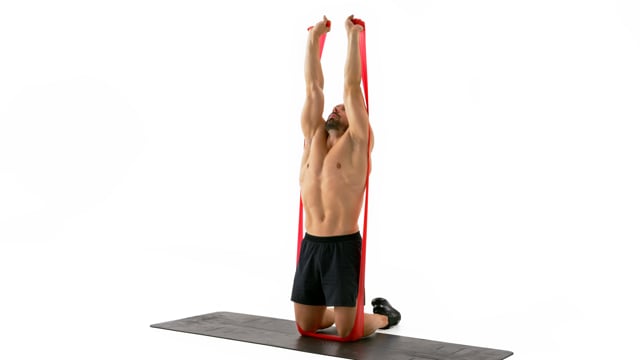
Lock your elbows and look at your hands.Reach towards the ceiling pushing as tall as you can and cover your ears with your shoulders. Make sure the elastic comes out of the back of your hands like an extension of your fingers and not from the thumb or pinky side.Go slow on the way down and keep your elbows locked. Both directions matter!
c f i l 12 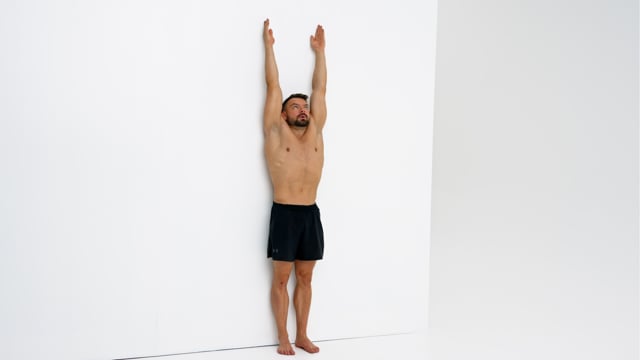
Keep your hands shoulder wide apart and lock your elbows.Mimic the handstand position by tilting your head back slightly and looking up towards the hands.Engage your core and avoid arching your back as good as you can!
c f i l 13 
On the bottom end of the body the elevation should be on the quads just before the knees.Look at your hands and keep them around shoulder width apart.Push your lower back up and engage your core to create an even and slightly rounded line.
c f i l 14 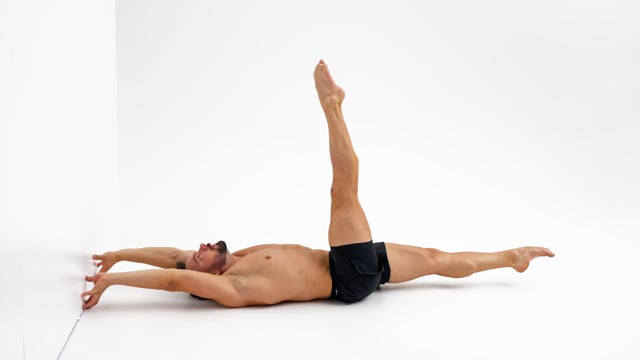
Keep your immobile leg engaged and hover the foot off the floor. Do not allow your hips to move at all during this drill.Lift your hands off the floor and push them into the wall hard by elevating your scapula. Try to cover your ears with your shoulders!Tilt your head back slightly and try to look at your hands to mimic the position you would be in when performing a handstand.
Rest between sets: As Needed
Intensity: Light
Technique Training
Rest between sets: Long enough to recover | Short enough to stay warm
Intensity: Moderate | Focus on form
workout_number sort_number Demo Exercise Reps/Sets How to/Cues
a 1 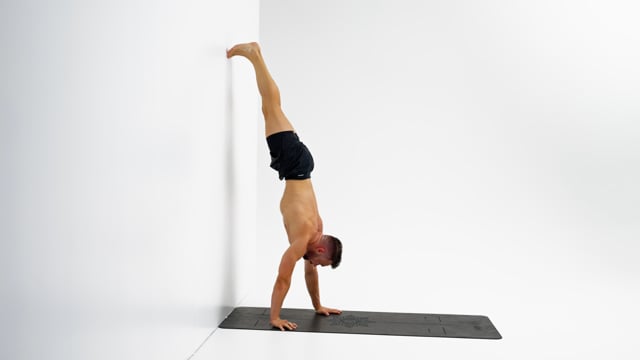
Take small and controlled steps with your hands facing towards the front.Only your feet should touch the wall. Do not place your knees, hips or chest on the wall.Look at the spot in between your hands. Do not look at the wall placing your chin on your chest.
a 2 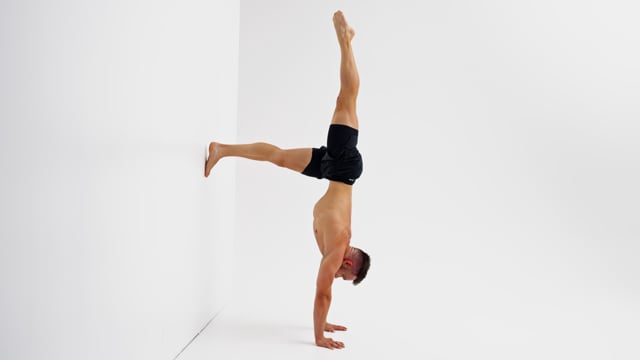
With the leg on top pressure on your shoulders is less horizontal and more vertical. Use this to push out extra tall. Work on holding this newly gained height on the way back down to the starting position.Engage your back and pull your hips into a slight anterior pelvic tilt when you are brining the leg back to the wall to keep your weight in the fingertips. Do not allow your lower back to round when returning to the L.In case of a temporary lack of hamstring flexibility bend your knee slightly to ease the tension.
a 3 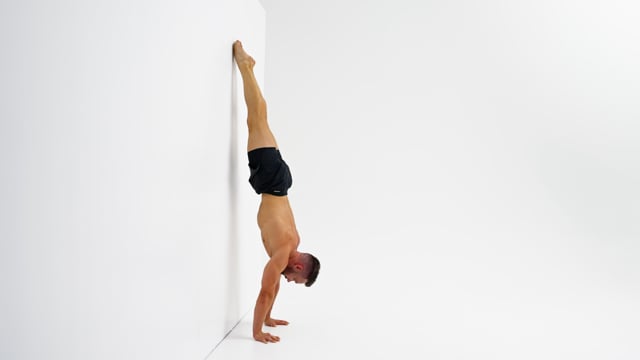
Do not pull your hips or arch your back. Stay in a perfectly straight line from shoulders to toes. The only position change should be in the shoulders and wrists.Do not place your hands too far away from the wall. The main focus of this drill is not conditioning but technical refinement.Keep your elbows locked and elevate your scapula fully at all times.
a 4 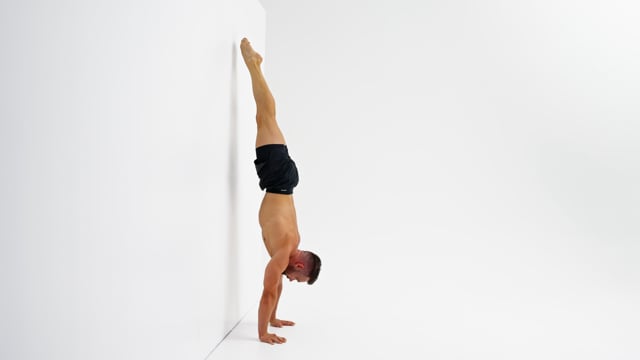
Do not pull your hips or arch your back. Stay in a perfectly straight line from shoulders to toes. The only position change should be in the shoulders and wrists.Move slow and stay in control at all times. Do not use momentum to get off the wall. Do not jump off the wall and do not take 1 foot at the time off the wall.Come back to the wall with your entire body from wrists to toes in 1 straight line.
a 5 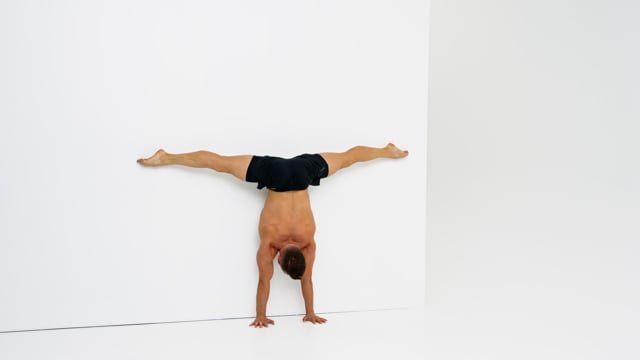
Keep your elbows locked and elevate your scapula fully at all times.Only your feet should touch the wall. Do not place your knees, hips or chest on the wall.Look at the spot in between your hands. Do not look at the wall placing your chin on your chest.
a 6 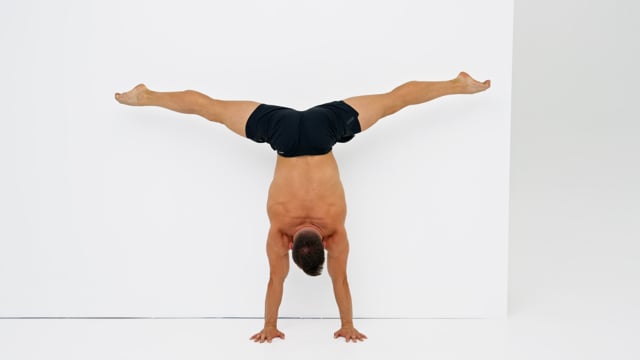
Don't just lock your legs inside of your hips but actively push them open. Do not accidentally close your legs whilst leaning towards the front., Lock your legs inside of your hips. Do not accidentally close your legs whilst leaning towards the front.Do not pull your hips or arch your back. Stay in a perfectly straight line from shoulders to toes. The only position change should be in the shoulders and wrists.Keep your elbows locked and elevate your scapula fully at all times.
a 7 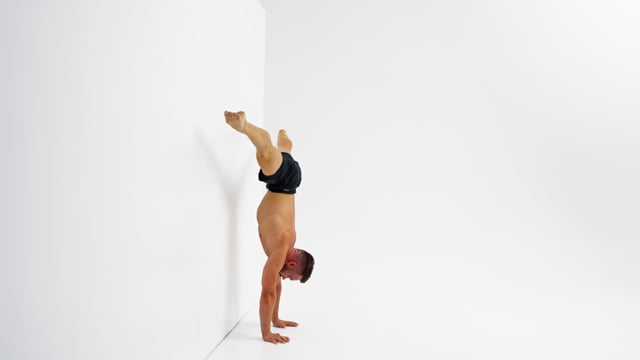
Open your legs into the straddle slowly. Not only will you have to catch your legs against gravity and momentum but also will your body become shorter. If your are not perfectly align this angle change will be surprising for your balance.Move slow and work on staying in control at all times. The goal is not just to jump from one position to the next but even to control the journey between the positions.Keep your elbows locked and elevate your scapula fully at all times.
a 8 
Engage your glutes whilst closing your legs to avoid piking at the hips.Move slow and work on staying in control at all times. The goal is not just to jump from one position to the next but even to control the journey between the positions.Keep your elbows locked and elevate your scapula fully at all times.
a 9 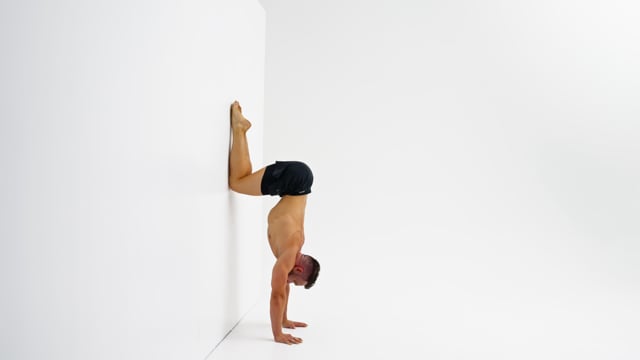
Keep your knees together and make them touch the wall as you pull them down.Pull your knees as low as possible whilst engaging your lower back. In the tuck position your hips need to be in a slight anterior pelvic tilt. As soon as your lower back rounds and your hips flip into a posterior pelvic tilt your knees are too low.Lock your elbows, elevate your scapula and look at the spot in between your hands.
a 10 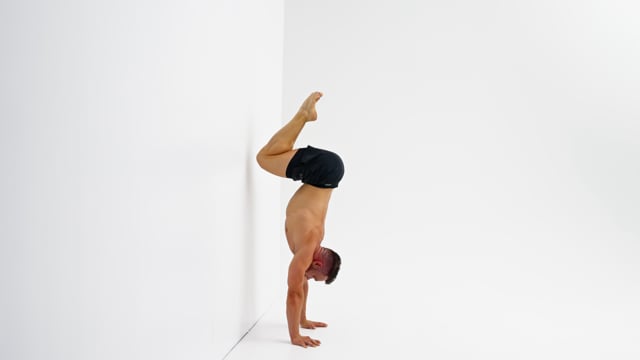
Do not jump off the wall or lean or shoulder excessively towards the front to get off the wall.Take both feet off the wall at the same time!Lock your elbows, elevate your scapula and look at the spot in between your hands.
a 11 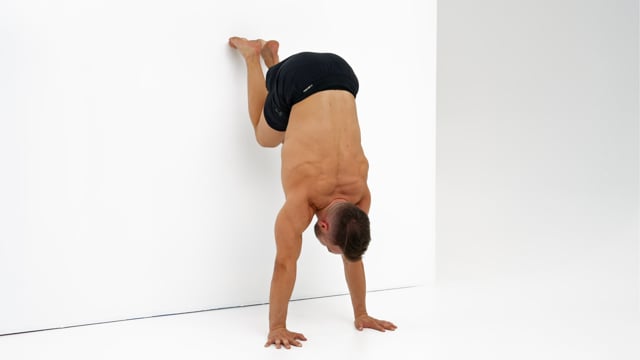
The closer you are to the wall the better but make sure you leave yourself enough room to clear the wall with your feet and knees.Keep your shoulders on top of the hands at all times.Look at the spot between your hands at all times!
12
13
14
15
16
17
18
19
20
21
22
23
24
b 25 
Take small and controlled steps with your hands facing towards the front.Only your feet should touch the wall. Do not place your knees, hips or chest on the wall.Look at the spot in between your hands. Do not look at the wall placing your chin on your chest.
b 26 
With the leg on top pressure on your shoulders is less horizontal and more vertical. Use this to push out extra tall. Work on holding this newly gained height on the way back down to the starting position.Engage your back and pull your hips into a slight anterior pelvic tilt when you are brining the leg back to the wall to keep your weight in the fingertips. Do not allow your lower back to round when returning to the L.In case of a temporary lack of hamstring flexibility bend your knee slightly to ease the tension.
b 27 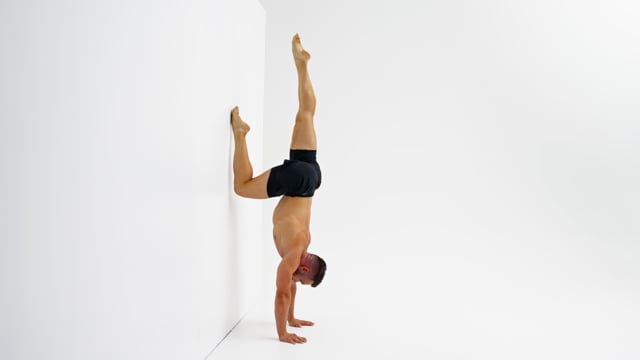
Isolate the single leg tuck slide. First bring the foot to the wall with a straight knee, then only pull the knee down.Keep your immobile leg perfectly on top of the hands, shoulders & hips. Do not arch it towards the back as a counterweight.Keep your elbows locked and elevate your scapula fully at all times.
b 28 
Don't just lock your legs inside of your hips but actively push them open. Do not accidentally close your legs whilst leaning towards the front., Lock your legs inside of your hips. Do not accidentally close your legs whilst leaning towards the front.Do not pull your hips or arch your back. Stay in a perfectly straight line from shoulders to toes. The only position change should be in the shoulders and wrists.Keep your elbows locked and elevate your scapula fully at all times.
b 29 
Open your legs into the straddle slowly. Not only will you have to catch your legs against gravity and momentum but also will your body become shorter. If your are not perfectly align this angle change will be surprising for your balance.Move slow and work on staying in control at all times. The goal is not just to jump from one position to the next but even to control the journey between the positions.Keep your elbows locked and elevate your scapula fully at all times.
b 30 
Engage your glutes whilst closing your legs to avoid piking at the hips.Move slow and work on staying in control at all times. The goal is not just to jump from one position to the next but even to control the journey between the positions.Keep your elbows locked and elevate your scapula fully at all times.
b 31 
Keep your knees together and make them touch the wall as you pull them down.Pull your knees as low as possible whilst engaging your lower back. In the tuck position your hips need to be in a slight anterior pelvic tilt. As soon as your lower back rounds and your hips flip into a posterior pelvic tilt your knees are too low.Lock your elbows, elevate your scapula and look at the spot in between your hands.
b 32 
Do not jump off the wall or lean or shoulder excessively towards the front to get off the wall.Take both feet off the wall at the same time!Lock your elbows, elevate your scapula and look at the spot in between your hands.
b 33 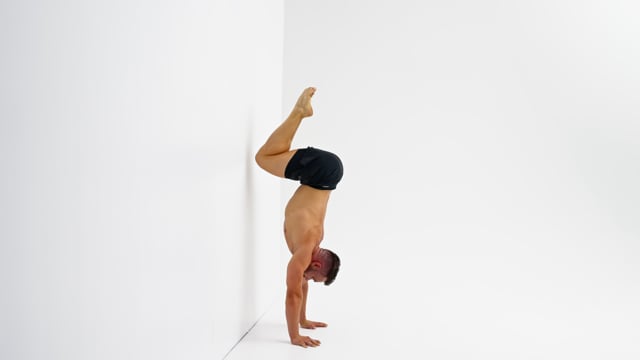
Focus on the rotation of your legs inside of your hips. In the tuck position they are in parallel. When you push them open into the straddle they are externally rotated with your knees looking towards the floor.Lift your legs. Do not let them hang behind in a pancake and drag you down.Start with a tight tuck. Pull your knees towards the chest using your hips flexors. Stop your hips from sliding into a posterior pelvic tilt through engagement of your lower back.
b 34 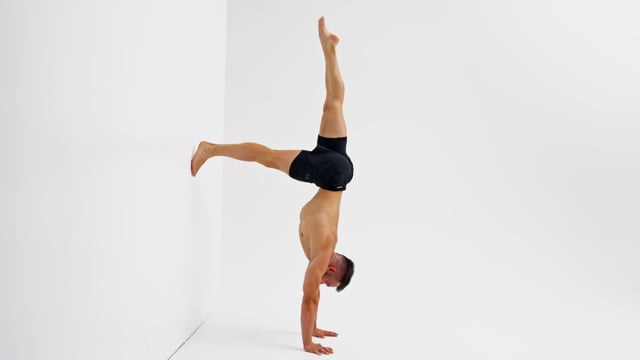
Stab the foot up straight towards the ceiling to align your top leg with the already aligned hands and shoulders. Do not arch the leg over towards the back.Keep your scapula elevated, elbows locked and and the weight in the fingertips at all times. Look at the space in between your hands and engage your legs!In case of a temporary lack of hamstring flexibility bend your wall knee slightly to ease the tension.
b 35 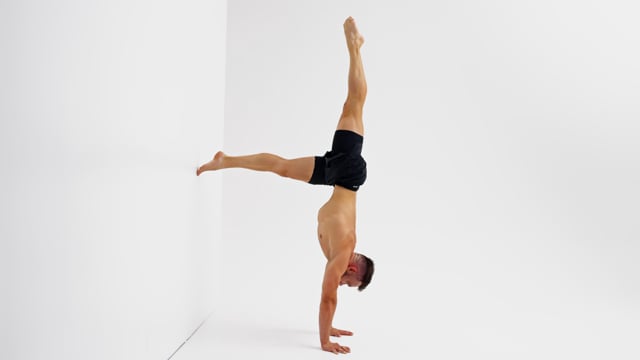
Stab the foot up straight towards the ceiling to align your top leg with the already aligned hands and shoulders. Do not arch the leg over towards the back.Keep your scapula elevated, elbows locked and and the weight in the fingertips at all times. Look at the space in between your hands and engage your legs!In case of a temporary lack of hamstring flexibility bend your wall knee slightly to ease the tension.
b 36 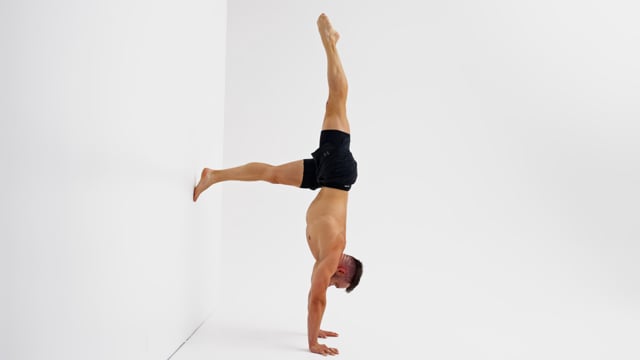
Stab the foot up straight towards the ceiling to align your top leg with the already aligned hands and shoulders. Do not arch the leg over towards the back.Keep your scapula elevated, elbows locked and and the weight in the fingertips at all times. Look at the space in between your hands and engage your legs!In case of a temporary lack of hamstring flexibility bend your wall knee slightly to ease the tension.
37
38
39
40
41
42
43
44
45
c 46 
Take small and controlled steps with your hands facing towards the front.Only your feet should touch the wall. Do not place your knees, hips or chest on the wall.Look at the spot in between your hands. Do not look at the wall placing your chin on your chest.
c 47 
Keep your knees together and make them touch the wall as you pull them down.Pull your knees as low as possible whilst engaging your lower back. In the tuck position your hips need to be in a slight anterior pelvic tilt. As soon as your lower back rounds and your hips flip into a posterior pelvic tilt your knees are too low.Lock your elbows, elevate your scapula and look at the spot in between your hands.
c 48 
Do not jump off the wall or lean or shoulder excessively towards the front to get off the wall.Take both feet off the wall at the same time!Lock your elbows, elevate your scapula and look at the spot in between your hands.
c 49 
Engage your glutes when pushing the legs up towards the straight handstand to avoid piking at the hips.Start with a tight tuck. Pull your knees towards the chest using your hips flexors. Stop your hips from sliding into a posterior pelvic tilt through engagement of your lower back.Lock your elbows, elevate your scapula and look at the spot in between your hands.
c 50 
Focus on the rotation of your legs inside of your hips. In the tuck position they are in parallel. When you push them open into the straddle they are externally rotated with your knees looking towards the floor.Lift your legs. Do not let them hang behind in a pancake and drag you down.Start with a tight tuck. Pull your knees towards the chest using your hips flexors. Stop your hips from sliding into a posterior pelvic tilt through engagement of your lower back.
c 51 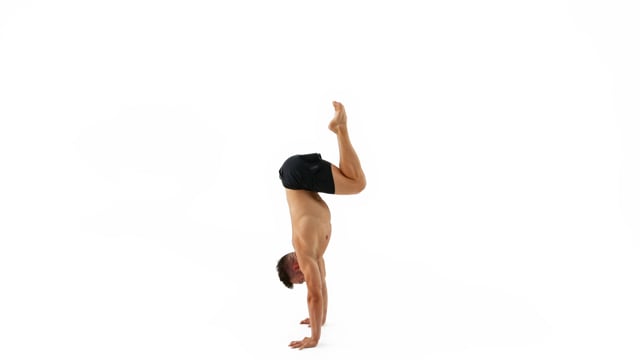
Keep your shoulders on top of the hands at all times.Use your hip flexors to pull your knees down towards your chest to minimize risk of falling over.Do not focus on holding the tuck. The goal is to jump to align the hips with the already aligned hands and shoulders and to come right back down.
c 52 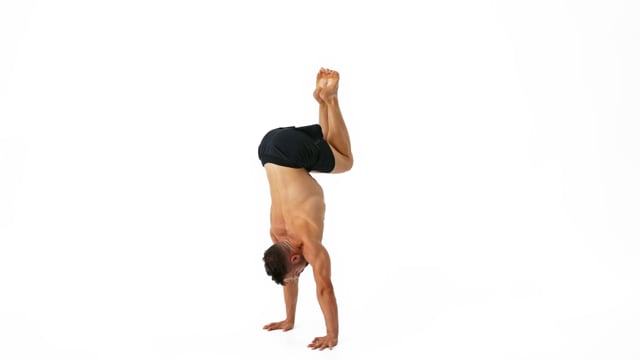
Use your hip flexors to pull your knees down towards your chest to minimize risk of falling over.Engage your lower back to pull on your hips. Do not allow your lower back to round or your shoulders to collapse towards the front.Keep your scapula elevated, elbows locked and and the weight in the fingertips at all times. Look at the space in between your hands and engage your legs!
c 53 
With the leg on top pressure on your shoulders is less horizontal and more vertical. Use this to push out extra tall. Work on holding this newly gained height on the way back down to the starting position.Engage your back and pull your hips into a slight anterior pelvic tilt when you are brining the leg back to the wall to keep your weight in the fingertips. Do not allow your lower back to round when returning to the L.In case of a temporary lack of hamstring flexibility bend your knee slightly to ease the tension.
c 54 
Do not pull your hips or arch your back. Stay in a perfectly straight line from shoulders to toes. The only position change should be in the shoulders and wrists.Move slow and stay in control at all times. Do not use momentum to get off the wall. Do not jump off the wall and do not take 1 foot at the time off the wall.Come back to the wall with your entire body from wrists to toes in 1 straight line.
c 55 
Don't just lock your legs inside of your hips but actively push them open. Do not accidentally close your legs whilst leaning towards the front., Lock your legs inside of your hips. Do not accidentally close your legs whilst leaning towards the front.Do not pull your hips or arch your back. Stay in a perfectly straight line from shoulders to toes. The only position change should be in the shoulders and wrists.Keep your elbows locked and elevate your scapula fully at all times.
c 56 
Open your legs into the straddle slowly. Not only will you have to catch your legs against gravity and momentum but also will your body become shorter. If your are not perfectly align this angle change will be surprising for your balance.Move slow and work on staying in control at all times. The goal is not just to jump from one position to the next but even to control the journey between the positions.Keep your elbows locked and elevate your scapula fully at all times.
c 57 
Engage your glutes whilst closing your legs to avoid piking at the hips.Move slow and work on staying in control at all times. The goal is not just to jump from one position to the next but even to control the journey between the positions.Keep your elbows locked and elevate your scapula fully at all times.
58
59
60
61
62
63
64
d 65 
Take small and controlled steps with your hands facing towards the front.Only your feet should touch the wall. Do not place your knees, hips or chest on the wall.Look at the spot in between your hands. Do not look at the wall placing your chin on your chest.
d 66 
Keep your elbows locked and elevate your scapula fully at all times.Only your feet should touch the wall. Do not place your knees, hips or chest on the wall.Look at the spot in between your hands. Do not look at the wall placing your chin on your chest.
d 67 
Do not pull your hips or arch your back. Stay in a perfectly straight line from shoulders to toes. The only position change should be in the shoulders and wrists.Move slow and stay in control at all times. Do not use momentum to get off the wall. Do not jump off the wall and do not take 1 foot at the time off the wall.Come back to the wall with your entire body from wrists to toes in 1 straight line.
d 68 
Don't just lock your legs inside of your hips but actively push them open. Do not accidentally close your legs whilst leaning towards the front., Lock your legs inside of your hips. Do not accidentally close your legs whilst leaning towards the front.Do not pull your hips or arch your back. Stay in a perfectly straight line from shoulders to toes. The only position change should be in the shoulders and wrists.Keep your elbows locked and elevate your scapula fully at all times.
d 69 
Open your legs into the straddle slowly. Not only will you have to catch your legs against gravity and momentum but also will your body become shorter. If your are not perfectly align this angle change will be surprising for your balance.Move slow and work on staying in control at all times. The goal is not just to jump from one position to the next but even to control the journey between the positions.Keep your elbows locked and elevate your scapula fully at all times.
d 70 
Engage your glutes whilst closing your legs to avoid piking at the hips.Move slow and work on staying in control at all times. The goal is not just to jump from one position to the next but even to control the journey between the positions.Keep your elbows locked and elevate your scapula fully at all times.
d 71 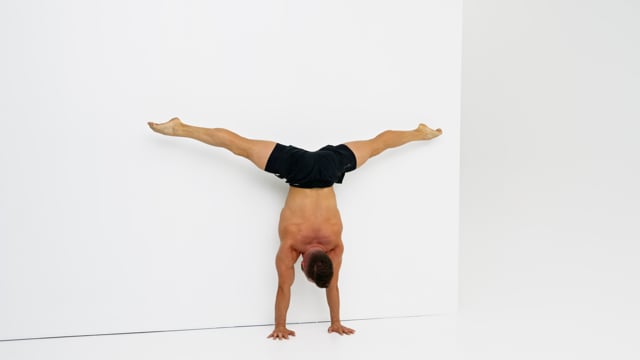
When your legs are together your feet should be in a parallel position. As soon as your legs open they have to rotate externally.Move slow and work on staying in control at all times. The goal is not just to jump from one position to the next but even to control the journey between the positions.Keep your scapula elevated, elbows locked and and the weight in the fingertips at all times. Look at the space in between your hands and engage your legs!
d 72 
Keep your knees together and make them touch the wall as you pull them down.Pull your knees as low as possible whilst engaging your lower back. In the tuck position your hips need to be in a slight anterior pelvic tilt. As soon as your lower back rounds and your hips flip into a posterior pelvic tilt your knees are too low.Lock your elbows, elevate your scapula and look at the spot in between your hands.
d 73 
Do not jump off the wall or lean or shoulder excessively towards the front to get off the wall.Take both feet off the wall at the same time!Lock your elbows, elevate your scapula and look at the spot in between your hands.
d 74 
Engage your glutes when pushing the legs up towards the straight handstand to avoid piking at the hips.Start with a tight tuck. Pull your knees towards the chest using your hips flexors. Stop your hips from sliding into a posterior pelvic tilt through engagement of your lower back.Lock your elbows, elevate your scapula and look at the spot in between your hands.
d 75 
Keep your shoulders on top of the hands at all times.Use your hip flexors to pull your knees down towards your chest to minimize risk of falling over.Do not focus on holding the tuck. The goal is to jump to align the hips with the already aligned hands and shoulders and to come right back down.
d 76 
Use your hip flexors to pull your knees down towards your chest to minimize risk of falling over.Engage your lower back to pull on your hips. Do not allow your lower back to round or your shoulders to collapse towards the front.Keep your scapula elevated, elbows locked and and the weight in the fingertips at all times. Look at the space in between your hands and engage your legs!
77
78
79
80
81
82
83
84
85
86
87
e 88 
Take small and controlled steps with your hands facing towards the front.Only your feet should touch the wall. Do not place your knees, hips or chest on the wall.Look at the spot in between your hands. Do not look at the wall placing your chin on your chest.
e 89 
With the leg on top pressure on your shoulders is less horizontal and more vertical. Use this to push out extra tall. Work on holding this newly gained height on the way back down to the starting position.Engage your back and pull your hips into a slight anterior pelvic tilt when you are brining the leg back to the wall to keep your weight in the fingertips. Do not allow your lower back to round when returning to the L.In case of a temporary lack of hamstring flexibility bend your knee slightly to ease the tension.
e 90 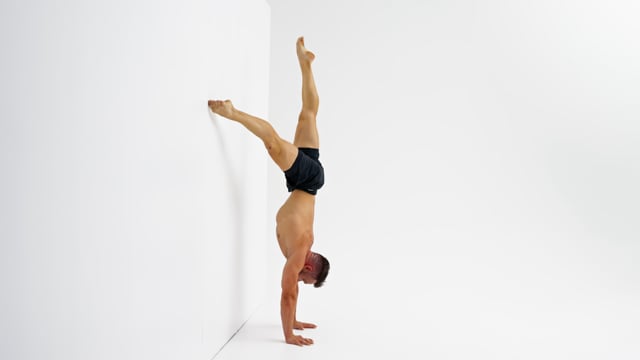
Focus on the rotation of your leg inside of your hip. In the straddle position the leg needs to be externally rotated. When the leg is on top and in the tuck position it needs to be in parallel.Focus on the immobile leg. Keeping it perfectly still is much harder than moving the other one in a circle.Due to the nature of this exercise you will be slightly piked in your single leg straddle position. This is ok as you gain lots of shoulder strength and coordination but moving the wall leg not just against gravity but also against the friction of the wall. Find a flat and even wall and wear slippery socks!
e 91 
Don't just lock your legs inside of your hips but actively push them open. Do not accidentally close your legs whilst leaning towards the front., Lock your legs inside of your hips. Do not accidentally close your legs whilst leaning towards the front.Do not pull your hips or arch your back. Stay in a perfectly straight line from shoulders to toes. The only position change should be in the shoulders and wrists.Keep your elbows locked and elevate your scapula fully at all times.
e 92 
Open your legs into the straddle slowly. Not only will you have to catch your legs against gravity and momentum but also will your body become shorter. If your are not perfectly align this angle change will be surprising for your balance.Move slow and work on staying in control at all times. The goal is not just to jump from one position to the next but even to control the journey between the positions.Keep your elbows locked and elevate your scapula fully at all times.
e 93 
Engage your glutes whilst closing your legs to avoid piking at the hips.Move slow and work on staying in control at all times. The goal is not just to jump from one position to the next but even to control the journey between the positions.Keep your elbows locked and elevate your scapula fully at all times.
e 94 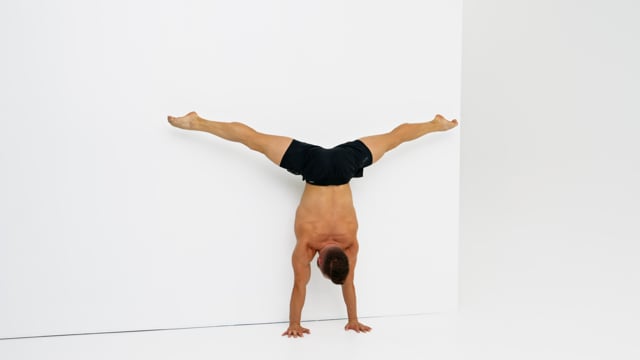
When your legs are together your feet should be in a parallel position. As soon as your legs open they have to rotate externally.Move slow and work on staying in control at all times. The goal is not just to jump from one position to the next but even to control the journey between the positions.Keep your scapula elevated, elbows locked and and the weight in the fingertips at all times. Look at the space in between your hands and engage your legs!
e 95 
Keep your knees together and make them touch the wall as you pull them down.Pull your knees as low as possible whilst engaging your lower back. In the tuck position your hips need to be in a slight anterior pelvic tilt. As soon as your lower back rounds and your hips flip into a posterior pelvic tilt your knees are too low.Lock your elbows, elevate your scapula and look at the spot in between your hands.
e 96 
Do not jump off the wall or lean or shoulder excessively towards the front to get off the wall.Take both feet off the wall at the same time!Lock your elbows, elevate your scapula and look at the spot in between your hands.
e 97 
Focus on the rotation of your legs inside of your hips. In the tuck position they are in parallel. When you push them open into the straddle they are externally rotated with your knees looking towards the floor.Lift your legs. Do not let them hang behind in a pancake and drag you down.Start with a tight tuck. Pull your knees towards the chest using your hips flexors. Stop your hips from sliding into a posterior pelvic tilt through engagement of your lower back.
e 98 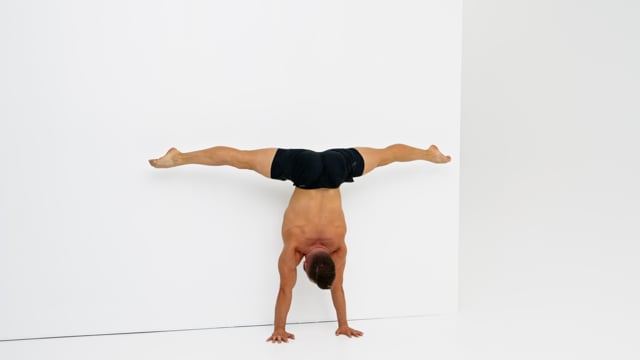
Pull your knees into a tight tuck on the way back to avoid touching the wall.Focus on the rotation of your legs inside of your hips. In the tuck position they are in parallel. When you push them open into the straddle they are externally rotated with your knees looking towards the floor.Lift your legs. Do not let them hang behind in a pancake and drag you down.
e 99 
Use your hip flexors to pull your knees down towards your chest to minimize risk of falling over.Engage your lower back to pull on your hips. Do not allow your lower back to round or your shoulders to collapse towards the front.Keep your scapula elevated, elbows locked and and the weight in the fingertips at all times. Look at the space in between your hands and engage your legs!
e 100 
Focus on your shoulders! Elevate your scapula, lock your elbows, look at your hands and keep your weight in your fingertips at all times.In the tuck position bring your knees low enough so that your are stable but hold them high enough so your lower back does not round. Engage the muscles of your lower back to pull your hips into a slight anterior pelvic tilt.In the straddle handstand push your legs open to lock them in place and to stabilize the position but keep your feet high enough so you do not pike at the hips.
101
102
103
104
105
f 106 
Take small and controlled steps with your hands facing towards the front.Only your feet should touch the wall. Do not place your knees, hips or chest on the wall.Look at the spot in between your hands. Do not look at the wall placing your chin on your chest.
f 107 
With the leg on top pressure on your shoulders is less horizontal and more vertical. Use this to push out extra tall. Work on holding this newly gained height on the way back down to the starting position.Engage your back and pull your hips into a slight anterior pelvic tilt when you are brining the leg back to the wall to keep your weight in the fingertips. Do not allow your lower back to round when returning to the L.In case of a temporary lack of hamstring flexibility bend your knee slightly to ease the tension.
f 108 
Do not pull your hips or arch your back. Stay in a perfectly straight line from shoulders to toes. The only position change should be in the shoulders and wrists.Move slow and stay in control at all times. Do not use momentum to get off the wall. Do not jump off the wall and do not take 1 foot at the time off the wall.Come back to the wall with your entire body from wrists to toes in 1 straight line.
f 109 
Isolate the single leg tuck slide. First bring the foot to the wall with a straight knee, then only pull the knee down.Keep your immobile leg perfectly on top of the hands, shoulders & hips. Do not arch it towards the back as a counterweight.Keep your elbows locked and elevate your scapula fully at all times.
f 110 
Do not jump off the wall or lean or shoulder excessively towards the front to get off the wall.Take both feet off the wall at the same time!Lock your elbows, elevate your scapula and look at the spot in between your hands.
f 111 
Engage your glutes when pushing the legs up towards the straight handstand to avoid piking at the hips.Start with a tight tuck. Pull your knees towards the chest using your hips flexors. Stop your hips from sliding into a posterior pelvic tilt through engagement of your lower back.Lock your elbows, elevate your scapula and look at the spot in between your hands.
f 112 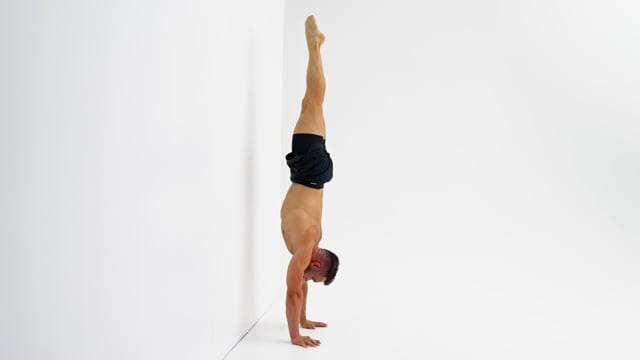
Time your hips and knees. If you were watching this drill from the side the feet should travel down and back up on 1 vertical line.Focus on your shoulders. Keeping them elevate is key here. Do not allow them to close or to slide towards the front.Pull your knees as low as possible in the tuck but stop before your lower back rounds. Engage the muscles in your lower back to pull your hips into a slight anterior pelvic tilt to support the weight of your legs.
f 113 
Don't just lock your legs inside of your hips but actively push them open. Do not accidentally close your legs whilst leaning towards the front., Lock your legs inside of your hips. Do not accidentally close your legs whilst leaning towards the front.Do not pull your hips or arch your back. Stay in a perfectly straight line from shoulders to toes. The only position change should be in the shoulders and wrists.Keep your elbows locked and elevate your scapula fully at all times.
f 114 
When your legs are together your feet should be in a parallel position. As soon as your legs open they have to rotate externally.Move slow and work on staying in control at all times. The goal is not just to jump from one position to the next but even to control the journey between the positions.Keep your scapula elevated, elbows locked and and the weight in the fingertips at all times. Look at the space in between your hands and engage your legs!
f 115 
When your legs are together your feet should be in a parallel position. As soon as your legs open they have to rotate externally.Move slow and work on staying in control at all times. The goal is not just to jump from one position to the next but even to control the journey between the positions.Keep your scapula elevated, elbows locked and and the weight in the fingertips at all times. Look at the space in between your hands and engage your legs!
f 116 
Use your hip flexors to pull your knees down towards your chest to minimize risk of falling over.Engage your lower back to pull on your hips. Do not allow your lower back to round or your shoulders to collapse towards the front.Keep your scapula elevated, elbows locked and and the weight in the fingertips at all times. Look at the space in between your hands and engage your legs!
f 117 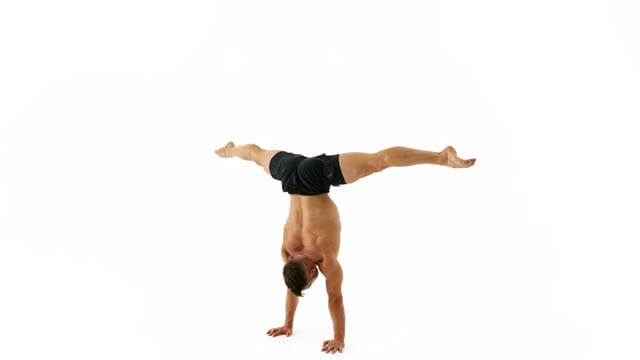
Move slow and work on staying in control at all times. The goal is not just to jump from one position to the next but even to control the journey between the positions.In the straddle handstand push your legs open to lock them in place and to stabilize the position but keep your feet high enough so you do not pike at the hips.In the tuck position bring your knees low enough so that your are stable but hold them high enough so your lower back does not round. Engage the muscles of your lower back to pull your hips into a slight anterior pelvic tilt.
118
119
120
121
122
123
124
g 125 
Take small and controlled steps with your hands facing towards the front.Only your feet should touch the wall. Do not place your knees, hips or chest on the wall.Look at the spot in between your hands. Do not look at the wall placing your chin on your chest.
g 126 
Keep your knees together and make them touch the wall as you pull them down.Pull your knees as low as possible whilst engaging your lower back. In the tuck position your hips need to be in a slight anterior pelvic tilt. As soon as your lower back rounds and your hips flip into a posterior pelvic tilt your knees are too low.Lock your elbows, elevate your scapula and look at the spot in between your hands.
g 127 
Focus on the rotation of your leg inside of your hip. In the straddle position the leg needs to be externally rotated. When the leg is on top and in the tuck position it needs to be in parallel.Focus on the immobile leg. Keeping it perfectly still is much harder than moving the other one in a circle.Due to the nature of this exercise you will be slightly piked in your single leg straddle position. This is ok as you gain lots of shoulder strength and coordination but moving the wall leg not just against gravity but also against the friction of the wall. Find a flat and even wall and wear slippery socks!
g 128 
With the leg on top pressure on your shoulders is less horizontal and more vertical. Use this to push out extra tall. Work on holding this newly gained height on the way back down to the starting position.Engage your back and pull your hips into a slight anterior pelvic tilt when you are brining the leg back to the wall to keep your weight in the fingertips. Do not allow your lower back to round when returning to the L.In case of a temporary lack of hamstring flexibility bend your knee slightly to ease the tension.
g 129 
Do not pull your hips or arch your back. Stay in a perfectly straight line from shoulders to toes. The only position change should be in the shoulders and wrists.Do not place your hands too far away from the wall. The main focus of this drill is not conditioning but technical refinement.Keep your elbows locked and elevate your scapula fully at all times.
g 130 
Do not pull your hips or arch your back. Stay in a perfectly straight line from shoulders to toes. The only position change should be in the shoulders and wrists.Move slow and stay in control at all times. Do not use momentum to get off the wall. Do not jump off the wall and do not take 1 foot at the time off the wall.Come back to the wall with your entire body from wrists to toes in 1 straight line.
g 131 
Isolate the single leg tuck slide. First bring the foot to the wall with a straight knee, then only pull the knee down.Keep your immobile leg perfectly on top of the hands, shoulders & hips. Do not arch it towards the back as a counterweight.Keep your elbows locked and elevate your scapula fully at all times.
g 132 
Keep your elbows locked and elevate your scapula fully at all times.Only your feet should touch the wall. Do not place your knees, hips or chest on the wall.Look at the spot in between your hands. Do not look at the wall placing your chin on your chest.
g 133 
Don't just lock your legs inside of your hips but actively push them open. Do not accidentally close your legs whilst leaning towards the front., Lock your legs inside of your hips. Do not accidentally close your legs whilst leaning towards the front.Do not pull your hips or arch your back. Stay in a perfectly straight line from shoulders to toes. The only position change should be in the shoulders and wrists.Keep your elbows locked and elevate your scapula fully at all times.
g 134 
Open your legs into the straddle slowly. Not only will you have to catch your legs against gravity and momentum but also will your body become shorter. If your are not perfectly align this angle change will be surprising for your balance.Move slow and work on staying in control at all times. The goal is not just to jump from one position to the next but even to control the journey between the positions.Keep your elbows locked and elevate your scapula fully at all times.
g 135 
Engage your glutes whilst closing your legs to avoid piking at the hips.Move slow and work on staying in control at all times. The goal is not just to jump from one position to the next but even to control the journey between the positions.Keep your elbows locked and elevate your scapula fully at all times.
g 136 
When your legs are together your feet should be in a parallel position. As soon as your legs open they have to rotate externally.Move slow and work on staying in control at all times. The goal is not just to jump from one position to the next but even to control the journey between the positions.Keep your scapula elevated, elbows locked and and the weight in the fingertips at all times. Look at the space in between your hands and engage your legs!
g 137 
When your legs are together your feet should be in a parallel position. As soon as your legs open they have to rotate externally.Move slow and work on staying in control at all times. The goal is not just to jump from one position to the next but even to control the journey between the positions.Keep your scapula elevated, elbows locked and and the weight in the fingertips at all times. Look at the space in between your hands and engage your legs!
138
139
140
141
h 142 
Take small and controlled steps with your hands facing towards the front.Only your feet should touch the wall. Do not place your knees, hips or chest on the wall.Look at the spot in between your hands. Do not look at the wall placing your chin on your chest.
h 143 
With the leg on top pressure on your shoulders is less horizontal and more vertical. Use this to push out extra tall. Work on holding this newly gained height on the way back down to the starting position.Engage your back and pull your hips into a slight anterior pelvic tilt when you are brining the leg back to the wall to keep your weight in the fingertips. Do not allow your lower back to round when returning to the L.In case of a temporary lack of hamstring flexibility bend your knee slightly to ease the tension.
h 144 
Keep your knees together and make them touch the wall as you pull them down.Pull your knees as low as possible whilst engaging your lower back. In the tuck position your hips need to be in a slight anterior pelvic tilt. As soon as your lower back rounds and your hips flip into a posterior pelvic tilt your knees are too low.Lock your elbows, elevate your scapula and look at the spot in between your hands.
h 145 
Do not jump off the wall or lean or shoulder excessively towards the front to get off the wall.Take both feet off the wall at the same time!Lock your elbows, elevate your scapula and look at the spot in between your hands.
h 146 
Time your hips and knees. If you were watching this drill from the side the feet should travel down and back up on 1 vertical line.Focus on your shoulders. Keeping them elevate is key here. Do not allow them to close or to slide towards the front.Pull your knees as low as possible in the tuck but stop before your lower back rounds. Engage the muscles in your lower back to pull your hips into a slight anterior pelvic tilt to support the weight of your legs.
h 147 
Pull your knees into a tight tuck on the way back to avoid touching the wall.Focus on the rotation of your legs inside of your hips. In the tuck position they are in parallel. When you push them open into the straddle they are externally rotated with your knees looking towards the floor.Lift your legs. Do not let them hang behind in a pancake and drag you down.
h 148 
Use your hip flexors to pull your knees down towards your chest to minimize risk of falling over.Engage your lower back to pull on your hips. Do not allow your lower back to round or your shoulders to collapse towards the front.Keep your scapula elevated, elbows locked and and the weight in the fingertips at all times. Look at the space in between your hands and engage your legs!
h 149 
Move slow and work on staying in control at all times. The goal is not just to jump from one position to the next but even to control the journey between the positions.In the straddle handstand push your legs open to lock them in place and to stabilize the position but keep your feet high enough so you do not pike at the hips.In the tuck position bring your knees low enough so that your are stable but hold them high enough so your lower back does not round. Engage the muscles of your lower back to pull your hips into a slight anterior pelvic tilt.
150
151
152
153
154
155
i 156 
Take small and controlled steps with your hands facing towards the front.Only your feet should touch the wall. Do not place your knees, hips or chest on the wall.Look at the spot in between your hands. Do not look at the wall placing your chin on your chest.
i 157 
With the leg on top pressure on your shoulders is less horizontal and more vertical. Use this to push out extra tall. Work on holding this newly gained height on the way back down to the starting position.Engage your back and pull your hips into a slight anterior pelvic tilt when you are brining the leg back to the wall to keep your weight in the fingertips. Do not allow your lower back to round when returning to the L.In case of a temporary lack of hamstring flexibility bend your knee slightly to ease the tension.
i 158 
Keep your elbows locked and elevate your scapula fully at all times.Only your feet should touch the wall. Do not place your knees, hips or chest on the wall.Look at the spot in between your hands. Do not look at the wall placing your chin on your chest.
i 159 
Don't just lock your legs inside of your hips but actively push them open. Do not accidentally close your legs whilst leaning towards the front., Lock your legs inside of your hips. Do not accidentally close your legs whilst leaning towards the front.Do not pull your hips or arch your back. Stay in a perfectly straight line from shoulders to toes. The only position change should be in the shoulders and wrists.Keep your elbows locked and elevate your scapula fully at all times.
i 160 
Engage your glutes whilst closing your legs to avoid piking at the hips.Move slow and work on staying in control at all times. The goal is not just to jump from one position to the next but even to control the journey between the positions.Keep your elbows locked and elevate your scapula fully at all times.
i 161 
When your legs are together your feet should be in a parallel position. As soon as your legs open they have to rotate externally.Move slow and work on staying in control at all times. The goal is not just to jump from one position to the next but even to control the journey between the positions.Keep your scapula elevated, elbows locked and and the weight in the fingertips at all times. Look at the space in between your hands and engage your legs!
i 162 
Focus on the rotation of your leg inside of your hip. In the straddle position the leg needs to be externally rotated. When the leg is on top and in the tuck position it needs to be in parallel.Focus on the immobile leg. Keeping it perfectly still is much harder than moving the other one in a circle.Due to the nature of this exercise you will be slightly piked in your single leg straddle position. This is ok as you gain lots of shoulder strength and coordination but moving the wall leg not just against gravity but also against the friction of the wall. Find a flat and even wall and wear slippery socks!
i 163 
Do not jump off the wall or lean or shoulder excessively towards the front to get off the wall.Take both feet off the wall at the same time!Lock your elbows, elevate your scapula and look at the spot in between your hands.
i 164 
Focus on the rotation of your legs inside of your hips. In the tuck position they are in parallel. When you push them open into the straddle they are externally rotated with your knees looking towards the floor.Lift your legs. Do not let them hang behind in a pancake and drag you down.Start with a tight tuck. Pull your knees towards the chest using your hips flexors. Stop your hips from sliding into a posterior pelvic tilt through engagement of your lower back.
i 165 
Pull your knees into a tight tuck on the way back to avoid touching the wall.Focus on the rotation of your legs inside of your hips. In the tuck position they are in parallel. When you push them open into the straddle they are externally rotated with your knees looking towards the floor.Lift your legs. Do not let them hang behind in a pancake and drag you down.
i 166 
Use your hip flexors to pull your knees down towards your chest to minimize risk of falling over.Engage your lower back to pull on your hips. Do not allow your lower back to round or your shoulders to collapse towards the front.Keep your scapula elevated, elbows locked and and the weight in the fingertips at all times. Look at the space in between your hands and engage your legs!
i 167 
Move slow and work on staying in control at all times. The goal is not just to jump from one position to the next but even to control the journey between the positions.In the straddle handstand push your legs open to lock them in place and to stabilize the position but keep your feet high enough so you do not pike at the hips.In the tuck position bring your knees low enough so that your are stable but hold them high enough so your lower back does not round. Engage the muscles of your lower back to pull your hips into a slight anterior pelvic tilt.
168
169
j 170 
Take small and controlled steps with your hands facing towards the front.Only your feet should touch the wall. Do not place your knees, hips or chest on the wall.Look at the spot in between your hands. Do not look at the wall placing your chin on your chest.
j 171 
With the leg on top pressure on your shoulders is less horizontal and more vertical. Use this to push out extra tall. Work on holding this newly gained height on the way back down to the starting position.Engage your back and pull your hips into a slight anterior pelvic tilt when you are brining the leg back to the wall to keep your weight in the fingertips. Do not allow your lower back to round when returning to the L.In case of a temporary lack of hamstring flexibility bend your knee slightly to ease the tension.
j 172 
Do not pull your hips or arch your back. Stay in a perfectly straight line from shoulders to toes. The only position change should be in the shoulders and wrists.Move slow and stay in control at all times. Do not use momentum to get off the wall. Do not jump off the wall and do not take 1 foot at the time off the wall.Come back to the wall with your entire body from wrists to toes in 1 straight line.
j 173 
Open your legs into the straddle slowly. Not only will you have to catch your legs against gravity and momentum but also will your body become shorter. If your are not perfectly align this angle change will be surprising for your balance.Move slow and work on staying in control at all times. The goal is not just to jump from one position to the next but even to control the journey between the positions.Keep your elbows locked and elevate your scapula fully at all times.
j 174 
When your legs are together your feet should be in a parallel position. As soon as your legs open they have to rotate externally.Move slow and work on staying in control at all times. The goal is not just to jump from one position to the next but even to control the journey between the positions.Keep your scapula elevated, elbows locked and and the weight in the fingertips at all times. Look at the space in between your hands and engage your legs!
j 175 
Keep your knees together and make them touch the wall as you pull them down.Pull your knees as low as possible whilst engaging your lower back. In the tuck position your hips need to be in a slight anterior pelvic tilt. As soon as your lower back rounds and your hips flip into a posterior pelvic tilt your knees are too low.Lock your elbows, elevate your scapula and look at the spot in between your hands.
j 176 
Do not jump off the wall or lean or shoulder excessively towards the front to get off the wall.Take both feet off the wall at the same time!Lock your elbows, elevate your scapula and look at the spot in between your hands.
j 177 
Engage your glutes when pushing the legs up towards the straight handstand to avoid piking at the hips.Start with a tight tuck. Pull your knees towards the chest using your hips flexors. Stop your hips from sliding into a posterior pelvic tilt through engagement of your lower back.Lock your elbows, elevate your scapula and look at the spot in between your hands.
j 178 
Time your hips and knees. If you were watching this drill from the side the feet should travel down and back up on 1 vertical line.Focus on your shoulders. Keeping them elevate is key here. Do not allow them to close or to slide towards the front.Pull your knees as low as possible in the tuck but stop before your lower back rounds. Engage the muscles in your lower back to pull your hips into a slight anterior pelvic tilt to support the weight of your legs.
j 179 
Keep your shoulders on top of the hands at all times.Use your hip flexors to pull your knees down towards your chest to minimize risk of falling over.Do not focus on holding the tuck. The goal is to jump to align the hips with the already aligned hands and shoulders and to come right back down.
j 180 
Use your hip flexors to pull your knees down towards your chest to minimize risk of falling over.Engage your lower back to pull on your hips. Do not allow your lower back to round or your shoulders to collapse towards the front.Keep your scapula elevated, elbows locked and and the weight in the fingertips at all times. Look at the space in between your hands and engage your legs!